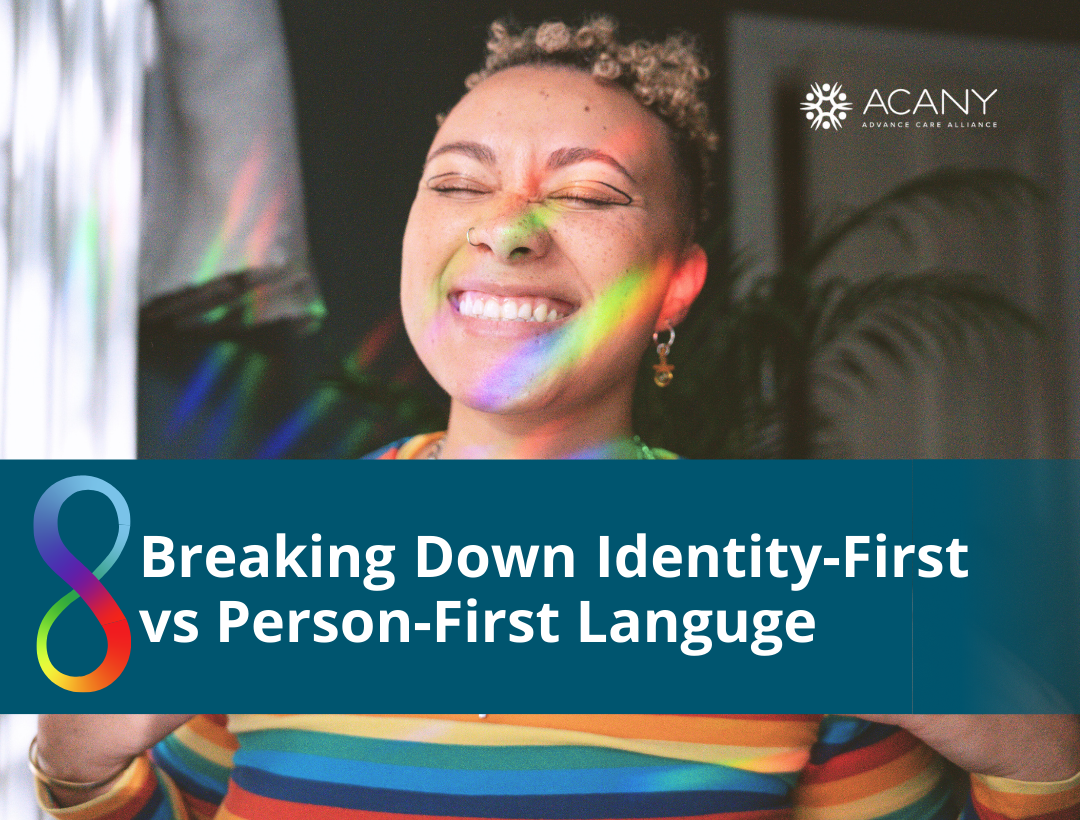One of the most complex discussions within the autism community is whether to use identity-first or person-first language. There are strong opinions on both sides, and perceptions have continued to shift as more self-advocates share their stories.
What is the difference?
Person-First Language: This approach places ‘person’ or ‘people’ before the condition or label. Examples include “people with autism” or “I have autism.”
Identity-First Language: This approach places the identity label before or in conjunction with the person label. Examples include “autistic people” or “I’m autistic.”
It’s important to note that identity-first language is not the right choice for every community. In this context, we are specifically discussing why many self-advocates in the autism community are pushing for this phrasing. One thing we can all agree on is that the person always has the final say on what language structure to use when talking to or about them. If you’re unsure which to use, just ask. The person will likely appreciate that you cared to ask their preference!
There are many language connotations that influence the argument for each side. Let’s break some of them down:
Respect and Dignity
Advocates for person-first language argue that phrasing such as “person with autism” emphasizes the individual over their condition, promoting respect and dignity. This approach helps combat stereotypes and generalizations often placed on those with different conditions and disabilities. It’s also important to note that ‘autistic’ has been used negatively in previous generations and was prevalent as a bullying term.
Moving From a Cure Mindset to Acceptance
Many self-advocates feel that person-first language reinforces the sentiment that autism is a condition to be cured or fixed, often comparing it to phrases such as “people with cancer” or “I have celiac disease.” There’s historical context to support this mindset. The push for what is now known as “person-first language” originated in 1983 during the AIDS crisis. An advocacy group in Denver coined the phrase “People With AIDS” to fight the stigma and dehumanization facing patients diagnosed with AIDS at the time. Seven years later, the Americans with Disabilities Act wrote person-first language into law (Wooldridge, 2023).
While we see the value and importance of person-first language in this context, the history of the phrasing provides insight into the deeper connotations felt by those in the autism community, where their diagnosis provides a sense of identity and community and isn’t something they wish to change or ‘fix.’
Acknowledging Autism as an Identity Marker
A self-advocate said it best:
“I am autistic. I am autistic in the same way I am gay, and I am white. I say ‘I am autistic’ because it is an inherent part of my identity in the same way being queer, white, and disabled are. These identities impact the way I exist and navigate within the world and my relationships. To remove autism from my identity is to also undermine the substantial influence it has had on my life, in all its beauty and challenges.
I am autistic, and as a result, I often get overstimulated, making places like the grocery store an immense struggle.
I am autistic, and as a result, I have an incredible capacity for creative thinking and am often complimented on my ability to think differently to solve problems.
Being autistic has had a direct impact on who I am today. Though it can be frustrating and has its challenges, I wouldn’t trade this part of me.”
What does the research say?
Taboas, Doepke, and Zimmerman (2022) examined preferences for identity-first versus person-first language among autism stakeholders in the U.S. While professionals tended to use person-first language, they found that 87% of autistic adults felt differently; “Overwhelmingly, autistic adults preferred identity-first language terms to refer to themselves or others with autism.”
We typically see the debate as ‘either-or,’ but, perhaps, the best choice is both. They are both appropriate depending on the context and situation. The AP Stylebook and the National Institutes of Health agree—our best strategies are to always ask the individual their preference and to switch between identity-first and person-first language structures as appropriate for the audience and context.
There are no clear guidelines for choosing when and how to decide between these options, but we can estimate which is a better fit depending on the use case.
When identity-first might be better:
- When the person has said they want to be referred to with identity-first language.
- When talking with or about that person, specifically about autism.
- Example: “Yes, she is autistic.” Or “We’d like to discuss how to get more support for our autistic child.”
- When the identity of autism is central to the conversation.
- Example: “They’re holding a gallery to feature autistic artists in the area.” Or “Autistic people can face unique challenges when seeking employment.”
When person-first might be better:
- When the person has said they want to be referred to with person-first language.
- When talking with or about that person and having autism is a secondary concern.
- Example: “How can we make this event more enjoyable for people with autism?” Or “He’s been struggling in class. Do you believe any of the challenges are related to him having autism?”
Ultimately, the choice between identity-first and person-first language is deeply personal and varies within the autism community. Both approaches have their merits and can be appropriate depending on the context. The most important takeaway is to respect the preferences of individuals and to ask them how they wish to be addressed. By doing so, we can foster a more inclusive and respectful environment for everyone.
References:
Wooldridge, S. (2023). Writing respectfully: Person-first and identity-first language. National Institutes of Health. Retrieved from https://www.nih.gov/about-nih/what-we-do/science-health-public-trust/perspectives/writing-respectfully-person-first-identity-first-language.
Taboas, A., Doepke, K., & Zimmerman, C. (2022). Preferences for identity-first versus person-first language in a US sample of autism stakeholders. Autism, 27(2), 565-570. https://doi.org/10.1177/13623613221130845 (Original work published 2023)

